An Environmental Lifecycle Assessment of Single-Use and Conventional Process Technology: Comprehensive Environmental Impacts
An environmental study of single-use process technology for biopharmaceutical manufacturing offers a comprehensive examination of environmental impacts across the full process train using lifecycle assessment.
Many biopharmaceutical companies have begun replacing traditional multi-use process equipment with single-use systems to improve flexibility, productivity, and cost (1-6). Adoption of single-use process technology reduces or eliminates the need for extensive cleaning and steam sterilization between batches but can introduce environmental impacts related to the manufacturing, use, and disposal of consumable materials.
Several previous studies have looked at environmental impacts of single-use biopharmaceutical manufacturing technologies (7-10). To further understand the balance of environmental impacts, GE Healthcare in collaboration with GE’s Ecoassessment Center of Excellence completed an extensive study of the lifecycle environmental impacts of the full process train required to produce monoclonal antibodies (mAbs). The study compares the use of single-use technologies vs. traditional durable stainless-steel process technologies at 100-L, 500-L, and 2000-L working volume scales. The scales were chosen to reflect typical clinical and commercial manufacturing scales. Process data were derived in collaboration with BioPharm Services Ltd., developer of BioSolve Process, an industry standard bioprocess model that can be used to build any process including those for manufacture of mAbs, vaccines, and bacterial-based products.
This environmental study of single-use process technology is the first to offer a comprehensive examination of environmental impacts across the full process train using lifecycle assessment (LCA). LCA is an internationally recognized discipline that can be used to examine products and processes from an environmental perspective across the full lifecycle of a product or process, from raw material extraction and refining through manufacturing, use, and end-of-life disposal or recycling. The methods involve analyzing material and energy flows from cradle-to-grave to calculate potential environmental impacts. This study was performed in accordance with the international standards ISO 14040 and ISO 14044 (11-12). The study was evaluated by a third-party critical review panel per ISO 14044 as the study involves comparative assertions. The critical review panel consisted of an independent LCA expert and two domain experts from the biopharmaceutical manufacturing industry (13).
A previously published companion article showed that a shift from traditional durable process technology to single-use process technology can result in substantial reductions in cumulative energy demand, global warming potential, and water usage for the production of mAbs (14). This article summarizes the results of a more comprehensive analysis focused on environmental impacts related to ecosystems, human health, and resources (15).
Methodology
This study compares the environmental impacts of producing mAbs using either single-use or traditional process technologies. The full process trains were evaluated at 100-L, 500-L, and 2000-L working volume scales. Calculations were based on a 10-batch campaign assuming 6 g/L titers.
Scope
The scope of this study includes the full process train categorized into 14 unit operations (i.e., fermentation N-2, fermentation N-1, bioreactor, depth filtration clarification, bioburden reduction I, protein A chromatography, virus inactivation, bioburden reduction II, no tank bioburden reduction, capture ion exchange chromatography, flow-through ion exchange chromatography, viral filtration, ultrafiltration/diafiltration, sterile filtration II), plus an aggregated operation termed ‘Support CIP/SIP System’ that includes shared services such as the clean-in-place/steam-in-place (CIP/SIP) generation systems, process water, media preparation, common hold and buffer tanks, and heating, ventilation, and air conditioning (HVAC) requirements. A process schematic is available in previous publications (14,15). Resources used in the preparation of media and buffer solutions were attributed to the unit operation in which the solution was used.
This study did not address the potential for a smaller production facility enabled by the choice of single-use technology, but the floor space used per HVAC class for each technology was scaled to the required facility footprint. This approach assumed that a traditional technology facility is in place and single-use technology is adapted to the existing facility.
Although a variety of single-use technology is available from different manufacturers, this study focused on GE technology wherever appropriate due to the greater availability of internal data and the desire to identify opportunities for environmentally conscious product design. This study did not address any potential differences in labor requirements.
Lifecycle Inventory Analysis
The main body of data used in this study was derived in collaboration with BioPharm Services Ltd. and can be considered industry average based on a combination of primary and secondary sources. Data on production of single-use components were obtained primarily from GE Healthcare. Data on transportation, packaging, and end-of-life were gathered through a combination of supplier data (GE Healthcare) and expert interviews. Additional secondary data were obtained from the ecoinvent 2.2 lifecycle inventory database (16). The lifecycle assessment models were developed in SimaPro Analyst version 7.2.4 lifecycle assessment software (17).
Key Assumptions
To maintain sterility, traditional durable equipment must be cleaned and steamed in place (CIP/SIP) between each batch. This process requires a large amount of purified water, water for injection (WFI), acids, and bases. The energy and supporting equipment required are all considered in this analysis. Single-use components that contact media do not require rigorous cleaning and sterilization, but instead are pre-sterilized by off-site Cobalt-60 (Co-60) irradiation. The transport of single-use components to and from the facility is included as well as the facility’s operating energy, the Co-60 source, and the concrete required for the irradiation cell. These impacts are allocated to each irradiated component as a mass fraction of irradiation facility throughput.
The traditional durable equipment is nominally assumed to have 10-year lifetimes, after which 25% of the equipment is re-used while the remainder is either recycled (90%) or landfilled (10%). The single-use process trains contain components that are designed to be used once and then discarded. The exceptions are the replacement of single-use chromatography columns, which are typically reused for several batches depending on the number of cycles per batch. In this case, a recommended usable life for a ReadyToProcess Capto S 2.5 Chromatography (GE Healthcare) column is 20-50 cycles. The LCA model assumed seven cycles per batch for protein A and five cycles per batch for ion exchange chromatography (at 2000-L scale). The number of cycles for traditional chromatography is assumed to be two cycles per batch for both protein A and ion exchange chromatography.
Several assumptions were made regarding treatment at end-of-life. For single-use components such as bioreactor bags, filters, and connectors, disposal was assumed to occur via hazardous waste incineration without waste heat recovery. Non-hazardous waste was sent to landfill or wastewater treatment. Purified water and WFI was assumed to be used once without recovery.
Use-phase electricity was assumed to be from an average US grid mix. Selection of an average European electricity grid mix exhibits lower environmental impacts but does not lead to any discernable shift of relative magnitudes between single-use and traditional process technology.
The fuel mix for generation of WFI was composed of different ratios of fuel oil, natural gas, and electricity. The default mixture was equally weighted for fuel oil and natural gas at 45% each while electricity was weighted at 10%.
Lifecycle Impact Assessment
Impact assessment methods are used to convert the lifecycle inventory data (i.e., material, energy, and emissions inputs and outputs throughout the product lifecycle for each component or activity) into a set of environmental impacts. The results in this paper focus on the ReCiPe midpoint and endpoint impact assessment method (18). The ReCiPe method is one of the most recent and comprehensive impact assessment methods available to LCA practitioners. The method addresses a wide range of environmental concerns at the midpoint level and then aggregates the 18 midpoints into a set of three endpoint damage categories (Table I). Midpoint impacts reflect the impact at a common midpoint in the cause-effect chain, while endpoint impacts assess the measure of the damage caused by that stressor at the end of the cause-effect chain.
ReCiPe Midpoint (H) V1.04 /
World ReCiPe H
ReCiPe Endpoint (H) V1.04 /
World ReCiPe H/A
Midpoint impact category
Unit
Endpoint impact category
Damage category
Unit
Climate change
kg CO2 eq
Climate change Human Health
Human Health
DALY
Ozone depletion
kg CFC-11 eq
Ozone depletion
Human Health
DALY
Human toxicity
kg 1,4-DB eq
Human toxicity
Human Health
DALY
Photochemical oxidant
formation
kg NMVOC
Photochemical oxidant
formation
Human Health
DALY
Particulate matter formation
kg PM10 eq
Particulate matter formation
Human Health
DALY
Ionizing radiation
kg U235 eq
Ionizing radiation
Human Health
DALY
Terrestrial acidification
Kg SO2 eq
Climate change Ecosystems
Ecosystems
species.yr
Freshwater eutrophication
kg P eq
Terrestrial acidification
Ecosystems
species.yr
Marine eutrophication
kg N eq
Freshwater eutrophication
Ecosystems
species.yr
Terrestrial ecotoxicity
kg 1,4-DB eq
Terrestrial ecotoxicity
Ecosystems
species.yr
Freshwater ecotoxicity
kg 1,4-DB eq
Freshwater ecotoxicity
Ecosystems
species.yr
Marine ecotoxicity
kg 1,4-DB eq
Marine ecotoxicity
Ecosystems
species.yr
Agricultural land occupation
m2a
Agricultural land occupation
Ecosystems
species.yr
Urban land occupation
m2a
Urban land occupation
Ecosystems
species.yr
Natural land transformation
m2
Natural land transformation
Ecosystems
species.yr
Metal depletion
m3
Metal depletion
Resources
surplus cost
Fossil depletion
kg Fe eq
Fossil depletion
Resources
surplus cost
Water depletion
kg oil eq
-
-
-
The damage categories considered are human health, ecosystems, and resources. Human health is expressed in units of disability adjusted life years (DALYs) and covers fate, exposure, effect, and damage analyses. The ecosystems damage category reflects the percentage of species that disappear in a certain area due to the environmental load, expressed in units of species per year (potentially disappeared fraction [PDF] m2 yr-). Finally, the resources damage category represents the increased cost to society for future extraction of the depleted resource, expressed in economic units.
Results and DiscussionFigure 1shows the lifecycle midpoint impacts for single-use vs. traditional process technology for the full process train with a 2000-L working volume. Traditional impacts are normalized to 100%, and single-use impacts are expressed relative to traditional impacts within each impact category. The single-use approach exhibits lower environmental impact in all 18 midpoint impact categories studied.
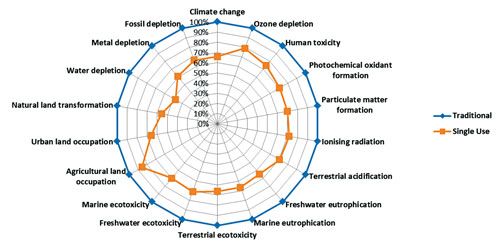
Figure 2 shows the lifecycle endpoint impacts grouped into three damage categories (i.e., human health, ecosystems, resources) and differentiated by lifecycle stage (i.e., supply chain, use phase, end-of-life). Supply chain includes materials and manufacturing of all process equipment and consumables required to support a 10-batch mAb production campaign. Use phase includes all impacts that occur during mAb production, including cleaning and sterilization of traditional durable equipment between batches. End-of-life includes the disposal of consumables and the disposal, re-use, or recycling of allocated portions of durable components. Traditional impacts are normalized to 100% within each damage category, and single-use impacts are expressed relative to traditional impacts within each damage category (note that impacts should only be compared within each damage category and not across damage categories). Single-use process technology exhibits lower endpoint impacts compared to traditional process technology within each damage category. The majority of impacts for both single-use and traditional process technology occur during use phase, predominantly due to environmental impacts associated with large amounts of energy used for steam generation, water purification, and equipment operation. Supply chain impacts contribute from 4-8% of the total lifecycle impacts, and end-of-life impacts contribute less than 1%.
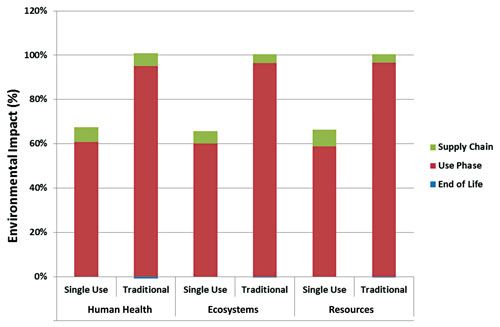
Figure 3 examines the contribution of individual endpoint impacts within each damage category. In this plot, the sum of impacts for traditional process technology within each damage category is normalized to 100%, and the impacts of single-use process technology are expressed relative to the traditional impacts. For both single-use and traditional process technology, the predominant impacts within the human health damage category are climate change (impact on human health), particulate matter formation, and human toxicity. The predominant impacts within the ecosystems category are climate change (impact on ecosystems), and within the resources category are fossil depletion. Single-use process technology exhibits lower impact compared to traditional process technology within each of these individual impact categories. Note that the predominant impact categories within each damage category (climate change, particulate matter formation, fossil depletion) are related to energy generation and use. This is primarily due to the large amount of energy required for operation of equipment, generation of WFI, and clean steam associated with traditional CIP/SIP support processes.
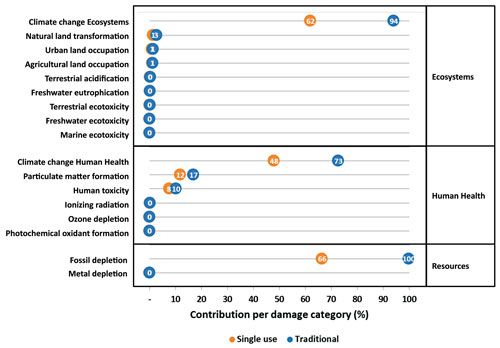
Figure 4 shows the contribution of each unit operation to environmental impact within each damage category. The single-use process technology exhibits lower environmental impacts in almost all of the unit operations, with the exception of protein A and capture ion exchange chromatography where the single-use alternative has slightly higher impacts than the traditional process technology. This is mainly due to the assumption in this study that multiple single-use columns are used in place of one traditional column and the assumption that the single-use columns are reused, which requires that the columns undergo cleaning and rinsing steps analogous to that of the traditional columns.
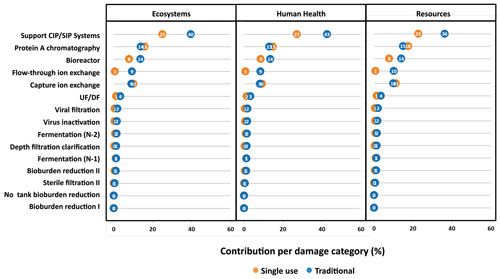
The largest operational contributor to environmental impact for both single-use and traditional process technology in all three damage categories is the support CIP/SIP systems, which include shared services such as the CIP/SIP generation systems, process water, media preparation, common hold and buffer tanks, and HVAC requirements. The most influential contributions to environmental impact within this unit operation are the energy to operate the CIP/SIP skids and other support systems and the steam required to maintain process equipment to set-point temperatures. The CIP/SIP energy needed by the single-use process technology is significantly less than that of the traditional process technology because the single-use process requires much less steam, water, and cleaning fluids, and the size of the required support systems can be reduced significantly. This overall reduction in size and operational support results in much smaller energy demand.
The next largest contributions from unit operations come from the bioreactor and from the chromatography steps (protein A, capture ion exchange, and flow through ion exchange chromatography). For the bioreactor, the largest contributors to environmental impact are associated with energy generation and use. For the traditional bioreactor this includes steam for process temperature set-point control and steam and WFI for cleaning and sterilization. The single-use bioreactor is electrically heated (heating is more efficient due to lower thermal mass) and requires no cleaning or sterilization.
Although the protein A chromatography unit operation is a significant contributor to environmental impact across the full process train for both process technologies, the difference in impact between single-use and traditional is less than 2% within each damage category. More detailed discussion regarding the Support CIP/SIP Systems, bioreactor, and Protein A chromatography unit operations are reported elsewhere (15).
End-of-life impacts contribute very little to the overall lifecycle impacts for both single-use and traditional process technology, as was seen in Figure 1. The single-use process does contribute greater environmental impact at end-of-life mainly due to the disposal of single-use consumable components. In contrast, the reuse of durable components at the end of their primary life results in positive environmental benefits.
The sensitivity of the study results to variations in key assumptions was extensively analyzed using a Plackett-Burman experimental design (15). None of the variations in key assumptions had a notable effect on the study conclusions.
Although the results shown in Figures 1-4 focused on the 2000-L working volume scale, similar results were obtained at 100-L and 500-L scales. The comparisons between single-use and traditional process technology apply at each of the three scales studied.
Conclusions and Recommendations
This study has shown that single-use process technology can have less impact on the environment than traditional process technology in a broad range of environmental impact categories. For the conditions and equipment explored in this study, single-use process technology exhibited lower environmental impact compared to traditional process technology in all midpoint and endpoint damage categories that were considered. Although single-use process technology introduces a need for the production, distribution, and disposal of single-use components, it also reduces or eliminates the need for large quantities of steam, process water, and WFI.
Three of the unit operations were found to contribute a majority of impact for both single-use and traditional process technologies: support CIP/SIP system (includes shared services such as the CIP/SIP generation systems, process water, media preparation, common hold and buffer tanks, and HVAC requirements); bioreactor; and Protein A chromatography.
As sustainability concerns become more prevalent in business decision-making, the insights presented in this study can be helpful in planning or retro-fitting either single-use or traditional biopharmaceutical manufacturing facilities, as well as providing guidance for environmentally conscious product and process development for the biopharmaceutical manufacturing industry.
References
1. H. Haughney and J. Hutchinson, Genetic Engineering News 24(8) (2004).
2. A. Sinclair and M. Monge, BioProcess International 2(S9), 26-31 (2004).
3. A. Sinclair and M. Monge, BioProcess International 3(9) (2005).
4. M. Fuller and H. Pora, BioProcess International 6(10), 30-36 (2008).
5. C. Mintz, Life Science Leader, July 29 (2009), accessed September 14, 2011.
6. H. Pora and B. Rawlings, BioProcess International 7(4), 9-16 (2009).
7. L. Leveen, American Pharmaceutical Review 12(6), 72-79 (2009).
8. M. Mauter, BioProcess International 7(3), 18-29 (2009).
9. B. Rawlings and H. Pora, BioProcess International 7(2), 18-26 (2009).
10. A. Sinclair, L. Leveen, M. Monge, J. Lim, and S. Cox, BioPharm International Supplement, 2 November, 4-15 (2008).
11. ISO 14040, Environmental management - Life cycle assessment - Principles and framework, 2006.
12. ISO 14044, Environmental management - Life cycle assessment-Requirements and guidelines, 2006.
13. Dr. Pascal Lesage (CIRAIG), Dr. Dirk Böhm (Merck Serono), Ekta Mahajan (Genentech Inc.)
14. M. Pietrzykowski, W. Flanagan, V. Pizzi, A. Brown, A. Sinclair, M. Monge, BioPharm International Supplements 24(11), 30-38 (2011).
15. M. Pietrzykowski, W. Flanagan, V. Pizzi, A. Brown, A. Sinclair, M. Monge, Journal of Cleaner Production 41, 150-162 (2013).
16. ecoinvent Centre, The life cycle inventory data version 2.2. Swiss Centre for Life Cycle Inventories (2010).
17. PRe Consultants
18. Goedkoop M.J., Heijungs R, Huijbregts M., De Schryver A.;Struijs J., Van Zelm R, ReCiPe 2008, A life cycle impact assessment method which comprises harmonised category indicators at the midpoint and the endpoint level;
First edition Report I: Characterisation; Jan. 6 2009.
About the Authors
William Flanagan is director, Ecoassessment Center of Excellence, flanagan@ge.com, Matthew Pietrzykowski is a research chemist, bothat GE Global Research, 1 Research Circle, Niskayuna, NY 12309, USA. Vincent Pizzi is BioProcess Upstream Strategy Leader, at GE Healthcare, Westborough, MA. Andrew Brown is head of consultancy, A.Brown@biopharmservices.com, Andrew Sinclair is managing director, and Miriam Monge is vice-president, all at Biopharm Services Ltd., Unit 1, Chess Business Park, Moor Road, Chesham, Bucks HP5 1SD, United Kingdom.
This article appears in the BioPharm International 2014 Single-use Systems eBook.
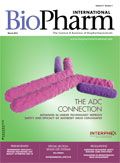
INTERPHEX 2025: Critical Role of Walk-In Chambers in Bio/Pharma Development and Manufacturing
April 3rd 2025Christopher Murphy, director of Global Business Development and Service Customer Support at Environmental Specialties, sat down with the PharmTech Group at INTERPHEX 2025 to discuss the design and critical role of walk-in chambers in the bio/pharmaceutical industry.
AES Clean Technology Launches Next-Generation OSM Utility Solution for Cleanrooms at INTERPHEX 2025
April 2nd 2025Officially launched at INTERPHEX 2025, the Omni ASCENT is a next-generation off-site manufactured vertical utility solution that offers optimized cleanroom flexibility and efficiency.